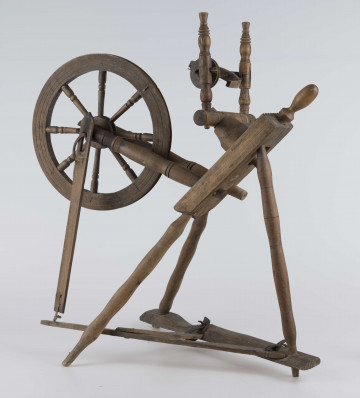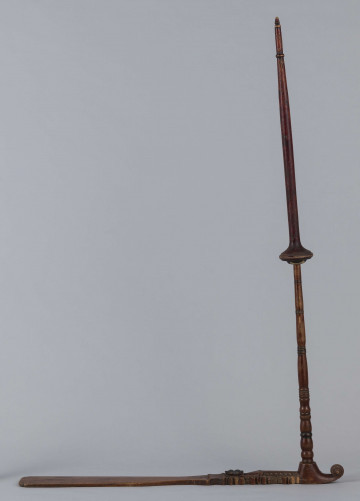
Horizontal spinning wheel
1901 — 1920
National Museum in Lublin
Part of the collection: Folk craft of the Lublin Region (19th/20th c.)
The reel, made by a craftsman in the early 20th century, was used in Dąbrowica near Lublin. It was made of dark brown wood (height 136 cm). The base is a stool (height 26 cm) with a rectangular outline, which has four turned legs with a span of 34 x 30 cm at the bottom. A footrest is attached underneath it - a pedal for propelling the flywheel using the leg. The pedal is attached with a vertical arm to the wheel axis. Three vertical turned columns are mounted in the stool. Between two of them an axle is placed and on it a drive wheel (diameter 40 cm) with decoratively turned spokes is fixed. Above the wheel a metal axle was fixed horizontally with a bobbin for winding the thread. The third column is used for attaching an arm with a spinning wheel and yarn (length 49 cm). The drive wheel is connected to the spool by a rope made of linen string put around the circumference of the wheel and the spool, which allows it to be set in motion. The spinning wheel was used to spin both animal fibres, i.e. wool, and bast fibres from flax and hemp. It is called a foot reel from the way it is propelled.
The woman, because it was she who did the spinning, would take a skein of fibre from the spinning wheel and twist it, either manually or with the help of a spindle, until she had a length of yarn of about one metre. She pulled the end of the yarn through a hole in the axis of the spindle and threaded it through one of the hooks on the wing and wound the end on a bobbin. Spinning required great skill and the thickness of the thread depended on the number of filaments taken. A more experienced and skilled person could make fine yarn, which was used in the weaving workshop to weave the fabric for Christmas clothes. Thicker thread was used for everyday clothing and bedding, and the thickest thread for sacks. Spinning wheels fell out of use in the first half of the 20th century, at which time home-made fabrics ceased to be produced. This was due to the development of the sewing industry and easy and relatively cheap access to fabrics and ready-made clothes.
Author / creator
Dimensions
cały obiekt: height: 136 cm, diameter: 40 cm
Object type
a reel
Material
wood
Creation time / dating
Creation / finding place
Owner
The National Museum in Lublin
Identification number
Location / status

1901 — 1920
National Museum in Lublin

1930
National Museum in Lublin

1928
National Museum in Lublin
DISCOVER this TOPIC
National Museum in Lublin
DISCOVER this PATH
Educational path